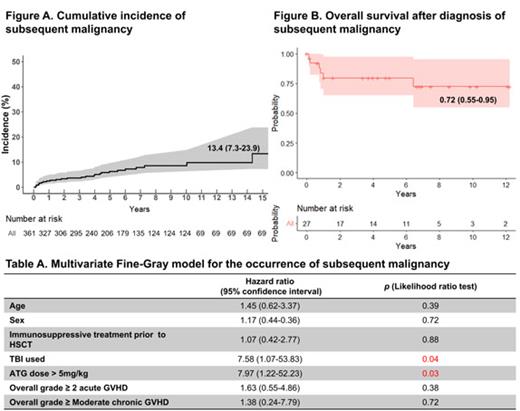The allogeneic hematopoietic stem cell transplantation (HSCT) is widely performed for the curative treatment of severe aplastic anemia (SAA). After HSCT, the long-term survival rates of SAA patients have substantially improved, with reported over 80%. However, as the post-HSCT survival period extends, there is a risk of exposure to long-term complications associated with HSCT. One such complication is the development of subsequent malignancies (SNs), which has observed to occur 2-5 times more frequently in HSCT recipients compared to age-matched controls. Although SN can have a critical impact on the survival of patients with SAA post-HSCT, there has been a lack of large-scale, long-term observational studies on the occurrence of SNs after HSCT in a disease of SAA. In this background, we investigated the incidence of SNs after HSCT in adult patients with SAA.
This study is a single-center retrospective cohort study conducted on adult patients with SAA who received HSCT from 2002 to 2021. We analyzed the frequency of SN that occurred after HSCT, and the SN types were denominated according to the Surveillance, Epidemiology, and End Results (SEER) database classification. In addition, the cumulative incidence of SNs were analyzed considering death as a competing risk, and the risk factors influencing the occurrence of SN after HSCT were examined using the Fine-Gray model.
Total 376 patients were included, and their median age at the time of HSCT was 35 (interquartile range, IQR: 27-46). Of them, 52.9% had received immunosuppressive treatment (ATG+CsA or CsA) before HSCT. HLA-matched sibling, unrelated, haplo-identical donors compromised of 48.7%, 31.6%, and 19.7%, respectively. During the observation period, 30 cases (7.2%) of SN were observed. one patient diagnosed with primary malignancies three times, and another patient having two primary malignancies. Among subsequent malignancies, 33.3% were hematologic malignancies, and 66.7% were solid malignancies. The frequencies of hematologic malignancies were as follows: Post-transplant lymphoproliferative disorder (23.3%), myelodysplastic neoplasm (6.7%), and acute myeloid leukemia (3.3%). The most common solid malignancies were thyroid cancer (26.7%), followed by stomach cancer (13.3%), oral cavity & pharyngeal cancer (10.0%), esophageal cancer (6.7%), bladder cancer, skin cancer, and cervical cancer (3.3% of each). The 15-year cumulative incidence of all malignancies was 13.4% (95% confidence interval [CI]: 7.3%-23.9%) (Figure A). After SN diagnosis, the overall survival rate from the diagnosis of SN (n=27) was 72.3% (95% CI: 55.0%-95.2%) at 12 years (Figure B). The 15-year post-HSCT survival rate for SN patients from the date of HSCT was 74.6% (95% CI: 85.6%-94.9%), which was significantly lower than the survival rate of patients who did not develop SN (n=334, 92.4% [95% CI: 89.6-95.2]) (Log-rank test p = 0.03). Factors identified to have significant impact to the occurrence of SN were the use of Total body irradiation (HR 7.58 [95% CI: 1.07-53.83]) and ATG usage of more than 5mg/kg (HR 7.97 [95% CI: 1.22-52.23]) during HSCT (Table A).
We observed occurrences of SN in a considerable proportion of SAA patients after HSCT. Our finding highlights that SN adversely affects survival, and the use of TBI and high dose of ATG were found to be significantly associated with SN occurrence. Therefore, SAA patients having these factors during conditioning regimen should be carefully monitored after HSCT.
Disclosures
Lee:Samsung: Consultancy; Kira: Consultancy; Arrowhead: Consultancy; AlloVir: Consultancy; Achillion: Research Funding; Alexion, AstraZeneca Rare Disease: Honoraria, Membership on an entity's Board of Directors or advisory committees, Research Funding.


This feature is available to Subscribers Only
Sign In or Create an Account Close Modal